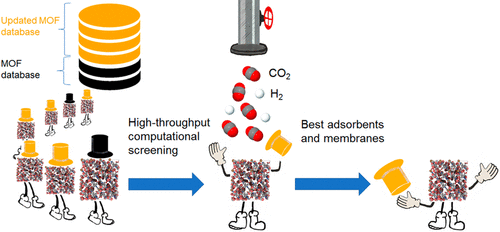当前位置:
X-MOL 学术
›
ACS Appl. Mater. Interfaces
›
论文详情
Our official English website, www.x-mol.net, welcomes your
feedback! (Note: you will need to create a separate account there.)
Do New MOFs Perform Better for CO2 Capture and H2 Purification? Computational Screening of the Updated MOF Database.
ACS Applied Materials & Interfaces ( IF 8.3 ) Pub Date : 2020-08-20 , DOI: 10.1021/acsami.0c12330 Gokay Avci 1 , Ilknur Erucar 2 , Seda Keskin 1
ACS Applied Materials & Interfaces ( IF 8.3 ) Pub Date : 2020-08-20 , DOI: 10.1021/acsami.0c12330 Gokay Avci 1 , Ilknur Erucar 2 , Seda Keskin 1
Affiliation

|
High-throughput computational screening of metal organic frameworks (MOFs) enables the discovery of new promising materials for CO2 capture and H2 purification. The number of synthesized MOFs is increasing very rapidly, and computation-ready, experimental MOF databases are being updated. Screening the most recent MOF database is essential to identify the best performing materials among several thousands. In this work, we performed molecular simulations of the most recent MOF database and described both the adsorbent and membrane-based separation performances of 10 221 MOFs for CO2 capture and H2 purification. The best materials identified for pressure swing adsorption, vacuum swing adsorption, and temperature swing adsorption processes outperformed commercial zeolites and previously studied MOFs in terms of CO2 selectivity and adsorbent performance score. We then discussed the applicability of Ideal Adsorbed Solution Theory (IAST), effects of inaccessible local pores and catenation in the frameworks and the presence of impurities in CO2/H2 mixture on the adsorbent performance metrics of MOFs. Very large numbers of MOF membranes were found to outperform traditional polymer and porous membranes in terms of H2 permeability. Our results show that MOFs that are recently added into the updated MOF database have higher CO2/H2 separation potentials than the previously reported MOFs. MOFs with small pores were identified as potential adsorbents for selective capture of CO2 from H2, whereas MOFs with high porosities were the promising membranes for selective separation of H2 from CO2. This study reveals the importance of enriching the number of MOFs in high-throughput computational screening studies for the discovery of new promising materials for CO2/H2 separation.
中文翻译:

新型MOF在捕获二氧化碳和净化氢气方面是否表现更好?更新的MOF数据库的计算筛选。
金属有机骨架(MOF)的高通量计算筛选可发现用于CO 2捕获和H 2纯化的新材料。合成MOF的数量正在迅速增加,并且正在更新可用于计算的实验MOF数据库。筛选最新的MOF数据库对于识别数千种性能最佳的材料至关重要。在这项工作中,我们对最新的MOF数据库进行了分子模拟,并描述了10 221个MOF对CO 2捕获和H 2的吸附和基于膜的分离性能纯化。确定的用于变压吸附,真空变压吸附和变温吸附工艺的最佳材料的性能超过了商用沸石,并且先前就MO 2的CO 2选择性和吸附剂性能评分进行了研究。然后,我们讨论了理想吸附溶液理论(IAST)的适用性,框架中难以接近的局部孔和连接的影响以及CO 2 / H 2混合物中杂质的存在对MOF吸附剂性能指标的影响。在H 2渗透性方面,发现非常大量的MOF膜优于传统的聚合物和多孔膜。我们的结果表明,最近添加到更新的MOF数据库中的MOF具有较高的CO比以前报道的MOF 2 / H 2分离电位。具有小的孔径的MOF被确定为CO的选择性捕获电位吸附剂2选自H 2,而具有高孔隙度的MOF是为h的选择性分离的有前途的膜2从CO 2。这项研究揭示了在高通量计算筛选研究中丰富MOF数量对于发现CO 2 / H 2分离新材料的重要性。
更新日期:2020-09-16
中文翻译:

新型MOF在捕获二氧化碳和净化氢气方面是否表现更好?更新的MOF数据库的计算筛选。
金属有机骨架(MOF)的高通量计算筛选可发现用于CO 2捕获和H 2纯化的新材料。合成MOF的数量正在迅速增加,并且正在更新可用于计算的实验MOF数据库。筛选最新的MOF数据库对于识别数千种性能最佳的材料至关重要。在这项工作中,我们对最新的MOF数据库进行了分子模拟,并描述了10 221个MOF对CO 2捕获和H 2的吸附和基于膜的分离性能纯化。确定的用于变压吸附,真空变压吸附和变温吸附工艺的最佳材料的性能超过了商用沸石,并且先前就MO 2的CO 2选择性和吸附剂性能评分进行了研究。然后,我们讨论了理想吸附溶液理论(IAST)的适用性,框架中难以接近的局部孔和连接的影响以及CO 2 / H 2混合物中杂质的存在对MOF吸附剂性能指标的影响。在H 2渗透性方面,发现非常大量的MOF膜优于传统的聚合物和多孔膜。我们的结果表明,最近添加到更新的MOF数据库中的MOF具有较高的CO比以前报道的MOF 2 / H 2分离电位。具有小的孔径的MOF被确定为CO的选择性捕获电位吸附剂2选自H 2,而具有高孔隙度的MOF是为h的选择性分离的有前途的膜2从CO 2。这项研究揭示了在高通量计算筛选研究中丰富MOF数量对于发现CO 2 / H 2分离新材料的重要性。































 京公网安备 11010802027423号
京公网安备 11010802027423号